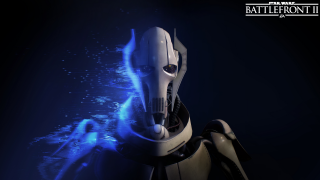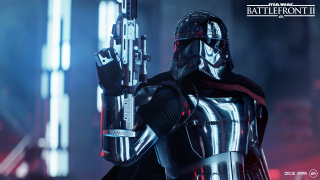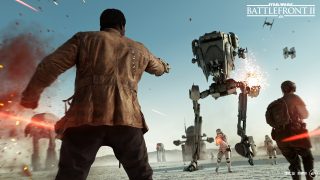General Grievous, Obi-Wan Kenobi, Count Dooku, and Anakin Skywalker are all making their way to Star Wars™ Battlefront™ II in the coming months. As we’re expanding the roster of cherished and feared Star Wars™ heroes and villains, we wanted to offer a behind-the-scenes look on how they’re crafted.
Our Hero Designer Guillaume Mroz has previously spoken to his own story and role at DICE. As a Hero Designer, Guillaume oversees the overall gameplay intention and assembly of heroes. However, as declared in the same article, there are multiple stakeholders involved that we haven’t detailed.
Furthermore, there’s an exhaustive method in place around getting the character ready for official deployment in game. We’ll cover this, too.
See this as the full report of how we’re bringing your favorite Star Wars characters to life. This is the making of a hero.

How and Why Certain Heroes Are Chosen for Star Wars Battlefront II
As our Design Director Dennis Brännvall shared in a recent interview here on the official Star Wars Battlefront II website, there’s always a bit of everything taken into account when content is added to the game. Same goes for heroes, specifically.
We start by asking ourselves some questions.
Who are the characters most requested by our players? Which Star Wars era, or eras, are we going for at the moment? What’s recommended from Lucasfilm, based on their knowledge? And, not to forget, who do we think would make an interesting character from a gameplay perspective?
These questions were asked and discussed when the development of Star Wars Battlefront II commenced. Later, knowing that we were expanding our heroes and villains roster from the current 16 to 20, those discussions were picked up again.
Given that more Clone Wars content has been a key request from the community – and the fact that we’re big fans of the Clone Wars era ourselves – both DICE and Lucasfilm were passionate about bringing more of its prominent characters to Star Wars Battlefront II.
Then, of course, a hero must counter a villain, and vice versa. With a production scope of four new heroes, one could quickly figure out that we needed to decide upon two Clone Wars characters from each side of the Force.
With Obi-Wan Kenobi being such a central figure in the prequel films, the Clone Wars series, and in the original trilogy, getting him into Star Wars Battlefront II was a big priority for us. The part his apprentice Anakin Skywalker played for the fate of the galaxy can similarly not be overstated. After all, there was a reason he was called The Chosen One.
Together, they fought the Separatists led by General Grievous and Count Dooku during the Clone Wars. As such, a natural rivalry was always present between the two duos. There are several other Clone Wars-era characters we and the community feel strongly about, but in the end, narrowing the selection down to these four made sense this time around.

Now, General Grievous is set to arrive in October, Obi-Wan Kenobi in November, Count Dooku in January, and Anakin Skywalker in February.
Our latest Roadmap update gives you a complete overview of all the to-date confirmed Clone Wars content.
Defining the Foundation of a Hero
With four new heroes to design and implement, documenting a design sheet for each, dictating the gameplay specifics, is next.
First, personality and gameplay intention need to be defined. Star Wars is a character-driven universe, so a lot of thought and work goes into getting the traits of the hero just right. This should ultimately outline how the character’s presence is perceived in game, and in this process our close relationship with Lucasfilm plays an important role.
For example, Obi-Wan was calm and a master of defensive lightsaber combat. This should then, naturally, be reflected in gameplay.
Looking at General Grievous, he was known to be a lethal commander and Jedi killer. But he was also quite the coward when the odds were turning against him. In the game, he’s designed to instigate fear in his enemies and to feel overwhelming. But he should also be able to escape in the blink of an eye.
Moving on to movement and attacks, we need to state how the hero should traverse the world and engage in combat, including how the character runs, jumps, evades, and attacks.
Along with the character’s traits, movement, and attacks are their special Abilities. The Abilities are usually tied to iconic actions that the character is known for, like Darth Vader’s Force Choke.
Before settling for the Abilities in game, a shortlist catering to different mechanics is discussed and tested together with Lucasfilm.
Giving Captain Phasma a grenade launcher was initially pitched as an interesting gameplay mechanic but was ultimately scrapped due to not being sufficiently grounded in her character. And at one point, Leia Organa was not powerful enough against lightsaber wielding opponents, so she was given the E-11 rapid fire blaster to answer to that need. This also aligned well with her character, as she used the same type of blaster in Star Wars™: Episode IV - A New Hope™.
Typically, there’s always a balance between authenticity and gameplay that needs to be struck.
When three to four Abilities are agreed upon, we start fine-tuning their effect and feel as we’re applying them to the hero.

Expanding the Hero Design Document
To progress your characters and heroes in Star Wars Battlefront II, you earn Skill Points to unlock Star Cards. Star Cards are specific to each hero and upgraded linearly as you play. They modify different aspects ranging from improvements to health, attack damage, altering of Abilities, and more.
Star Cards and their affects, stats, unlock order, and rank gate are then defined in the design document. Milestones are added as an extra layer to the hero’s progression as well, with specific missions to complete over time.
While wanting to offer a wide variety of playable characters, each of them also needs to have a certain degree of depth and customizability.
Added to this are the Emotes and Victory Poses available for all heroes. Normally, four of each are decided upon, specified in the design document, and eventually passed along to an animator. In the same way as Abilities, Emotes and Victory Poses should tie into the hero’s personality. Any additional Appearances are also presented here.
Bringing a Hero to Life with Art, Animations, Sound, and Visual Effects
Above, we’ve described something that could be mistaken for chronological process.
In reality, different crafts are brought in to work on the character in parallel as the design document is being worked on. A Development Manager will structure tasks and set up internal dependencies, so a hero can be built upon from several angles at the same time.
In this way, an artist can start creating the 3D model and its outfits as soon as the character and Appearances are decided upon. With the photorealistic style of Star Wars Battlefront II, the likeness from the films’ real-life actors and costumes are aimed at.

Some costumes we’ve been able to study up close, showcased in their original form at George Lucas’ Skywalker Ranch. For others, we’ve looked at detailed photographs and models directly from Lucasfilm’s reference archives.
An animator will also begin working on movements, motion-captured with the help of martial artists and actors, instructed to impersonate the style and feel of each individual hero.
In the case of the new Clone Wars heroes, references from the prequel films and the Clone Wars series alike are being looked at. Count Dooku engaged in combat elegantly and palm-down to showcase his superiority. Anakin Skywalker fought offensively. And so on.
When an ability is locked down, an UI designer gets going on how the area of effect should be visualized. And if the ability is related to say, the Force, a visual effects artist might add her touch to augment how that should feel.
The different crafts provide important feedback and expertise on what’s possible from their perspective. Adding a certain Appearance to a character may seem like a small addition at first glance, but depending on how it looks, it might not work with the intended animations and abilities of the character.
Sound is added later in the process, but planning starts early. Looking back at the design document, the sound engineer will find requirements for the sounds tied to the character, including saber movement, running, impact, and more.
Another big part of the sound palette is voiceover. Voiceover requires talent to be hired, scripts to be written, and voices to be recorded at a studio. Some lines will play when an Emote or Ability is triggered, and some are decided by context. For example, General Grievous says different things depending on if he’s in battle with a regular soldier or with his arch-nemesis Obi-Wan Kenobi.
The core pillars of the personality and behavior of the character are now in place.
Assembling the Pieces, Testing, Reiterating, and Releasing
All of the pieces making up a hero are assembled in FrostEd, a schematics-driven editor for the Frostbite game engine. Imagine lots of boxes with lots of lines in between, and you have the general idea.
For the designers to be able to quickly test and reiterate on the hero, the hero can quickly be brought into a test range.
The character will eventually reach alpha-stage and can finally be brought into a test build of the game. All DICE employees have access to these builds through a dedicated playtest-client, and playtests are booked to everyone’s calendars.
Then we play.
Some stuff might be missing, bugs are expected, and feedback is sent around. That’s all part of finalizing the character.
The excitement to finally be able to try out what everyone has been working so hard on is tangible. We test, reiterate, and test again, until we release the hero to the wild, as part of a game update to our players.
A hero is born.
–Daniel Steinholtz (Follow Daniel on Twitter @dsteinholtz)
Keep watching this space and EA Star Wars™ on Twitter, Facebook, and Instagram for more Star Wars Battlefront II related news, and please share your thoughts and feedback – and learn even more about our game – in the official forums.
Sign up today to receive the latest Star Wars Battlefront II news, updates, behind-the-scenes content, exclusive offers, and more (including other EA news, products, events, and promotions) by email.